Abstract
CFD offers advantages over wind tunnel experiments in the prediction and optimization of building wind environment; however, the computational costs associated with optimizing architectural wind environment remain a challenge. In this study, an approach that combines deep learning techniques with CFD simulations is proposed for the prediction and optimization of the architectural wind environment efficiently. A dataset of wind field is constructed using CFD simulation, considering various wind directions, wind speeds, and building spacing. Subsequently, a U-net deep learning model is trained as a surrogate model to rapidly predict the architectural wind field under different conditions. The results indicate that the model can accurately predict the wind field in buildings. The prediction time of building wind field is only 1/900 of that of CFD simulations, making it a viable surrogate model for wind environment optimization. Furthermore, considering all the building layouts and inflow conditions examined in this study, the maximum and minimum uniform wind speed area ratios Auni are 0.84 and 0.13, respectively. Under a single inflow speed, the maximum improvement in the Auni is 0.4, with an improvement rate of 48%. The results demonstrate the effectiveness of the proposed method as an efficient approach for optimizing architectural wind environment.
1. Introduction
With increasing economic development and urbanization, cities have experienced significant changes in their natural environment, resulting in unique urban microclimates. Wind environment has a significant impact on urban air quality and comfort because a favorable wind environment can dilute and remove pollutants accumulated in the city [1,2], providing good comfort [3]. As a renewable energy source, wind can provide necessary fresh air for buildings through natural ventilation, while also carrying away excess heat or cold indoors [4,5]. Therefore, cities can reduce their reliance on non-renewable energy sources. Hence, integrating wind energy into urban design and planning is becoming increasingly important, especially in the development of sustainable and energy-efficient buildings [6].
Therefore, optimizing the microclimate in architectural design is an essential part of urban planning, as it has significant practical implications for accurately assessing the surrounding microclimate and improving residents’ safety and comfort.
Field measurements, atmospheric boundary layer wind tunnel tests, and computational fluid dynamics (CFD) simulations are commonly used methods of studying the wind environment in architecture. However, field measurement methods can only be applied to existing buildings and are not effective during the urban planning phase. Atmospheric boundary layer wind tunnel tests utilize scaled models and simulate real atmospheric boundary layer conditions. They are widely employed in the study of urban wind fields, such as individual building [7] and shape optimization [8,9,10,11,12,13,14], building arrays [15,16], urban building clusters [17,18], and urban street canyons [19]. Wind tunnel experiments can simulate the inflow conditions in urban wind fields and provide relatively accurate simulations of the building microclimate. However, data collection within the flow field relies on a limited arrangement of wind speed measurement points, which cannot capture the entire flow field. Wind tunnel experiments also involve high equipment costs, substantial manpower, and time requirements, making it challenging to optimize the complex microclimate of a real city.
In recent years, CFD simulations have become an important method for studying the microclimate in architecture due to advancements in computer technology [20,21,22,23,24,25,26]. CFD methods allow for full-scale modeling of individual buildings or urban streets, with easily controllable boundary conditions. They can compute data for the entire flow field, enabling more detailed analysis of the flow field around buildings. This provides an effective means for studying the microclimate in architecture. Various modeling methods are used for simulating turbulence in urban wind fields, including Reynolds-averaged Navier–Stokes equations (RANS) [27,28], large-eddy simulation (LES) [29,30], and direct numerical simulation (DNS). DNS, due to its high computational cost, is not suitable for studying flow at the scale of buildings. LES, although having lower computational costs compared to DNS and higher accuracy than RANS [31], still presents challenges for engineering applications. However, for the optimization of urban microclimates, the high demand for data still poses a challenge in terms of computational costs for CFD methods.
The integration of deep learning and CFD enables the rapid prediction of flow fields, making it possible to overcome computational challenges. Guo et al. [32] proposed a model based on a convolutional neural network, which was used to predict steady flow through objects. Ozaki et al. [33] proposed a deep learning model for velocity field prediction of fixed cylinders and found that the model has good generalization for systems with a larger number cylinders. Miyanawala and Jaiman [34] proposed an efficient convolutional neural network (CNN) model to predict the coefficient of the cylindrical wake flow field under different two-dimensional geometry. Ribeiro et al. [35], using CNN architectures, achieved very accurate results for velocity and pressure fields of stationary fluids around simply shaped obstacles, with a computational cost three to five orders of magnitude lower than CFD simulations. Many problems of CNN in turbulent flow have also been studied. Duru et al. proposed a deep learning framework based on fully convolutional neural networks for predicting transonic flow fields [36] and pressure fields [37] with different airfoils. Fang et al. [38], using DL techniques, predicted turbulent flows on a channel, and Thuerey et al. [39] approximated the velocity and pressure fields of the RANS-based turbulence model on airfoils with a CNN. To achieve this, a CNN model was trained with the Signed Distance Field (SDF) [40] of building layouts and incoming wind speed as input data, and the wind fields obtained through CFD simulations as the output data. The trained model serves to expedite the optimization of architectural wind fields and exhibited high prediction efficiency and accuracy. Yu et al. [41] proposed a method to predict the saturation variation and flow velocity profile of two-dimensional multiphase flow in porous media and found that the prediction is consistent with the CFD results. Mokhtar et al. [42] used conditional generative adversarial networks to rapidly reconstruct the wind speed field of pedestrian height, but were unable to predict the velocity distribution under different inflow speeds. Graph Neural Networks (GNNs) can flexibly represent grid centers or nodes as vertices in graph data and are considered more suitable for prediction problems in unstructured grid CFD data structures. Consequently, GNN models are increasingly being applied in flow field prediction research. Wang et al. [43] constructed a GNN-based U-net network architecture for vortex structure recognition in unstructured grid CFD flow fields. Lino et al. [44] built a multi-scale GNN structure to predict flow fields around a series of length scales and complex boundary geometries. Shao et al. [45] used Graph Neural Networks to predict flow fields of different building layouts, with good consistency between predicted results and CFD simulation results. However, due to the complete flow field data used for each GNN training, there is a high demand for GPU memory and training costs are significant. To address this issue, Liu et al. [46] partitioned the graph data into multiple small graphs and trained them separately, thereby reducing the model’s dependence on GPU memory for training. Nevertheless, for three-dimensional flow, if one aims to fully represent grid data, GNN models require a large number of vertices and edges to represent grid information and the associations between grids, resulting in a dependency on GPU memory and high computational performance. Weerasuriya et al. [47] proposed a Gaussian Process-based emulator to achieve fast prediction of the wind velocity around single lift-up buildings with eight design parameters; the emulator achieved a speedup of 107 times over the CFD simulation in predicting wind velocity. Kim et al. [48] utilized a machine learning model to predict the unmeasured velocities around two adjacent building models by particle image velocimetry (PIV), thereby obtaining complete wind data. He et al. [49] proposed a hybrid framework with machine learning for accurate prediction of the low-velocity areas around buildings.
Therefore, deep learning models can serve as surrogate models to replace costly CFD simulations for efficient and accurate prediction of certain physical fields in addressing many problems. Thus, the utilization of deep learning models becomes highly significant in overcoming the expensive costs associated with traditional experiments or CFD simulations for optimizing the built environment’s wind conditions. However, previous studies of building wind environment on the integration of CFD and deep learning have mainly focused on the feasibility of the methods, with primary emphasis on the predictive performance of surrogate models, without leveraging the advantages of deep learning for optimization problem. Therefore, this paper aims to demonstrate the practical applicability of integrating CFD and deep learning in optimizing building wind environments to advance the field and promote its wider adoption and practical implementation in real-world engineering scenarios.
In this study, a deep learning-based surrogate model is proposed for the rapid and accurate prediction and optimization of building wind environments. Initially, the surrogate model is trained using CFD simulation data. Subsequently, this surrogate model is employed to achieve rapid prediction of wind environments, and the optimization of building wind environments is realized through evaluation of the predicted results.
2. Methods
As shown in Figure 1, the CFD method and deep learning method were employed for the rapid prediction and optimization of the wind environment around buildings. The schematic of the study includes four steps: data generation, model training, rapid prediction, and optimization. Initially, CFD simulations were conducted to simulate the wind field around the buildings and to generate data. The wind field data was then transformed into a dataset suitable for model training based on the CNN model. In this step, the U-net model was implemented using Python programming language and the Tensorflow open-source platform, encompassing processes such as model construction, training, and prediction. The model was then utilized for the prediction of the flow field under different building layouts and incoming flow conditions. Finally, the optimal combination of building layouts and incoming flow conditions was determined.
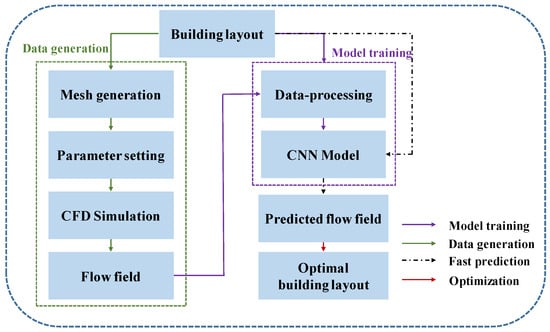
Figure 1.
Flow chart of the optimization process.
2.1. CFD Simulation
2.1.1. Numerical Model
For simulating urban wind fields, the use of LES and DNS can yield better results [31]. However, due to their high computational costs, it is challenging to generate datasets for constructing urban wind fields. RANS has been widely applied for simulating the building wind field [28,31], and the standard k − ε model has been proven to accurately simulate the flow field around buildings [50,51]. Therefore, in this study, the wind fields around the buildings are obtained by solving the equations of the standard k − ε model. In the model, the turbulent dissipation rate is estimated as:
Furthermore, turbulent viscosity μt can be expressed as a function of k and ε
where Cμ is an empirical constant. In the standard k − ε model, k and ε, are solved by the following transport equations
where is the former of turbulent kinetic energy k caused by mean velocity gradient, is the term of turbulent kinetic energy k caused by buoyancy, and YM represents the fluctuation expansion in compressible turbulence. ,, and are empirical constants. and are the Prandtl numbers corresponding to turbulent kinetic energy k and dissipation rate ε, respectively. and are user-defined source items. The coefficients are as follows:
The equations above are numerically solved by the commercial CFD software ANSYS Fluent 2022R2.
2.1.2. Computational Domain and Boundary Conditions
As shown in Figure 2, the objects studied in this paper are two square buildings arranged in parallel, the calculation domain is 700 m × 1300 m rectangular area. In this study, the commercial meshing software of ANSYS mesh was used for building the unstructured mesh in the present study and the grid near the buildings is refined with a minimum cell size of 0.2 × 0.2 m. The entrance is set as the velocity inlet, the outlet is set as the pressure outlet with the relative pressure of 0, the upper and lower boundaries of the calculation domain are set as the symmetry, and the building surface is set as the non-slip boundary. A square area measuring 256 m × 256 m around the building was selected to evaluate the wind environment in the vicinity of the buildings.
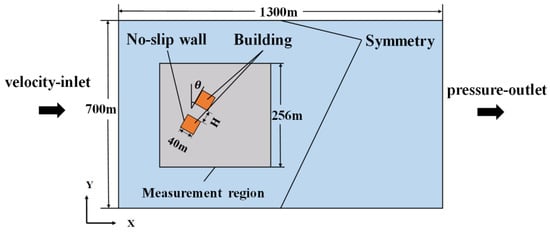
Figure 2.
Boundary conditions setting (yellow represents the building and gray represents the measurement region).
2.1.3. Validation
Wind tunnel experimental data by Meng and Hibi [52] was use for CFD validation by Yoshie et al. [53], and the experimental data was also utilized for validation of the CFD simulation in this paper. In the wind tunnel test for a single rectangular building, the analyzed flow field was around a building with a width of b = 0.08 m and a height of h = 2b; 60 measuring points were placed on horizontal plane at (z/b = 0.125) of the building height.
Numerical simulations were conducted based on the boundary conditions according to the wind tunnel experiment, and comparison of the velocity was made to validate the CFD method. The average wind velocity U measured in the wind tunnel experiments and the results obtained from the CFD simulation are shown in Figure 3. The results indicate that the velocity values obtained from the CFD simulation match well with the data obtained from the wind tunnel experiments, especially at x/d = 0.75 and y/b = 1.25, where the CFD simulation accurately captures the phenomenon of reverse flow consistent with experimental data and effectively represents the airflow characteristics around the building. Therefore, the proposed CFD simulation method can accurately simulate urban wind environments and can be used to generate the dataset required for this study.
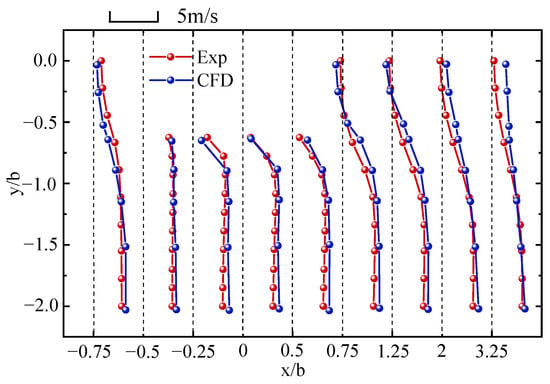
Figure 3.
Distribution of U in horizontal section (z = 0.125b).
2.2. Deep Learning Model Setup
U-net [54] convolutional auto-encoder architecture is proposed for accurate biomedical image segmentation, and the structure of U-net is U-shaped, as shown in Figure 4. U-net convolutional network consists of encoder and decoder. The encoder on the left is composed of multiple convolutions and down-sampling, which is mainly responsible for image features, and the decoder on the right is composed of multiple convolutions and up-sampling. It is mainly responsible for restoring the original resolution of feature map and fusing shallow and deep data features through skip connections. In order to achieve the consistency of the size of the feature map and the original data, the padding is set to 0. The encoder, as well as each corresponding decoder part, utilizes 3 × 3 convolutional kernels. The number of convolutional kernels is set as 16, 32, 64, 128, and 256. Each convolutional block performs two consecutive convolution operations on the input data, followed by the Rectified Linear Unit (ReLU) activation function to introduce non-linearity to the output signals. The model is implemented in the Python programming language, using the TensorFlow platform as the neural network framework. The computational setup consists of an Intel i5-13600kf processor, Intel, Santa Clara, CA, USA (3.5 GHz, 20 cores, 32 GB RAM) and an NVIDIA RTX4080 GPU, Nvidia, Santa Clara, CA, USA (16 GB). During the experimental process, a batch size of 20 is utilized, with 118 cases used for training and 78 cases for validation. The initial learning rate is set to 1 × 10−4, and as the training epochs increase, the learning rate is reduced to 6 × 10−5. The Adam [55] optimizer is chosen for optimization, and the total number of iterations is set to 200.
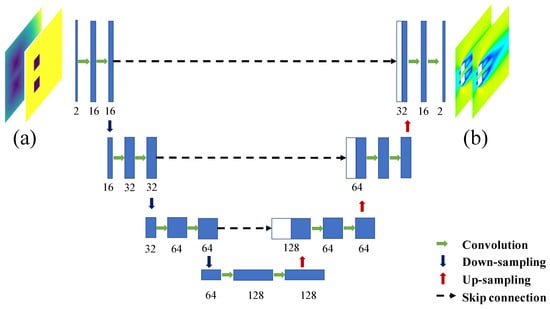
Figure 4.
Schematic of the structure of U-net method, (a) input data, (b) output data.
2.3. Dataset Generation
The layout of two square buildings side by side was considered; the side length of the square building is 40 m. In order to compare the building wind environment under different building layouts, 7 kinds of building spacing and 7 different incoming flow velocity directions were set. At the same time, four inflow speeds were considered in order to study the building wind environment of the same building layout under different wind speeds. Incoming flow velocity V, incoming flow wind direction Angle , and building spacing H are shown in Table 1.

Table 1.
Summary of parameter set of building layouts and boundary conditions in CFD simulations.
As illustrated in Figure 4a, the two-channel input data consist of two components; one is the SDF sampled on a Cartesian grid, providing a universal representation for global geometry and distance for various architectural layouts, and the other is the data representing the boundaries of the buildings, in which the building region is represented as 0 and the flow region is represented as 1.
ANSYS Fluent was used to simulate the wind field and to generate the output data. As the research goal was to explore the wind environment near the building, a part of the area near the building was selected for analysis. Since the dividing grid is an irregular quadrilateral and regular structured data must be used in the deep learning model, the post-processing software Tecplot 360 EX 2022 R1 was used to process the CFD results and interpolate the grid data onto the 256 × 256 Cartesian grid (Figure 4b).
This study mainly focused on the stable wind field distributions; however, the transient flow characteristics may have influence on wind environment, which was ignored in this study. Anyway, this paper only considers the influence of wind speed and building layout on the building wind environment, thus potentially overlooking other factors affecting the wind environment, such as temperature and humidity variations.
3. Results and Discussions
3.1. Deep Learning Model Accuracy Analysis
To evaluate the accuracy of the model, mean squared error (MSE) was chosen as the metric to assess the performance of the trained deep learning model on the validation set. A smaller MSE value indicates a smaller difference between the model’s predicted values and the actual values. The equation for MSE is shown as:
where n donates the number of samples, is the actual value, and donates the predicted value of the model. After 200 epochs of training, the learning rate of the model decreased to 6 × 10−5. The MSE loss of the model on the training and validation sets is depicted in Figure 5. The MSE loss demonstrates good convergence after 200 epochs, indicating an improvement in the accuracy of the model without overfitting during the training process.
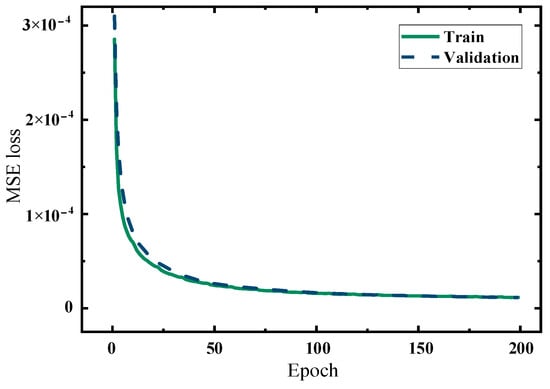
Figure 5.
MSE loss in training and validation process.
3.2. Flow Field Prediction Analysis
The qualitative representation of the error between the predictions of the deep learning model and the CFD computational results is shown in Figure 6. The velocity values of the building airflow field computed by CFD and the deep learning model are compared, and the error is calculated with
where represents the actual wind speed value computed by CFD and represents the predicted value of the deep learning model. If is 0, it indicates that the predicted values of the model match the CFD computational results.
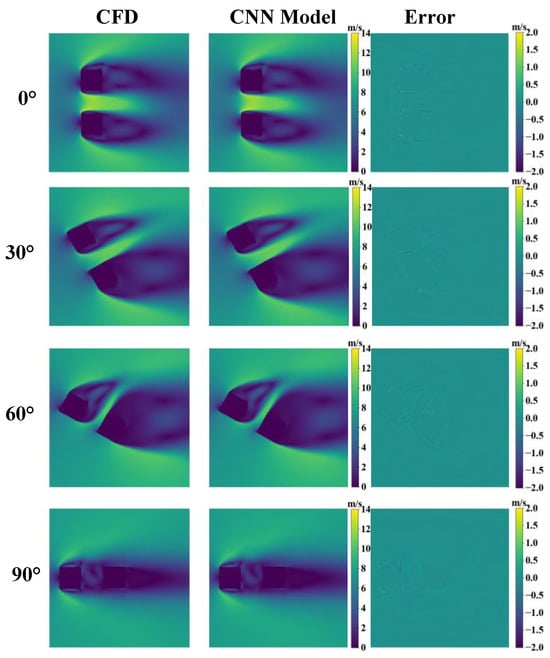
Figure 6.
Comparison between CFD simulation results and deep learning model predictions.
The results in Figure 6 demonstrate that the deep learning model aligns well with the CFD computational results in predicting the building airflow field. The error plot illustrates the exact discrepancies between the deep learning model and the CFD computational results. It can be observed that the overall flow characteristics of the building airflow field, as predicted by the deep learning model, are in good agreement with the CFD computational results. The errors are primarily concentrated in the flow separation regions near the edges of the building. This may be attributed to the complex flow conditions near the building edges, which are challenging to predict accurately. Nevertheless, the deep learning model has effectively learned the specific features of the building airflow field.
By comparing the CFD computational results with the predictions of the CNN model, as shown in Figure 7, a difference is made between the results of the average velocity of the wind field calculated by CFD and predicted by the CNN model. The red line represents the linear regression line of the CFD computational results, while the light red area represents the 95% prediction interval of the predicted values. It can be observed that the data points are mainly distributed within the 95% prediction interval, indicating that the CNN model can accurately predict the velocity values of the CFD-computed airflow field. There are only a few points outside the prediction interval, which can be attributed to differences in wind speeds resulting in variations in flow characteristics.
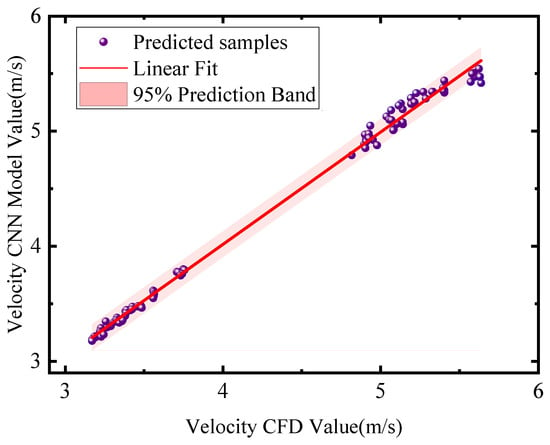
Figure 7.
Comparison between CFD simulation and model predictions results of mean velocity.
3.3. Flow Field Analysis
In this paper, due to the consideration of multiple wind speed values, the non-dimensional velocity K is regarded as an indicator of the flow field conditions which is shown in Equation (9), where U represents the incoming wind speed, while denotes the wind speed at a point in the building wind field.
Figure 8 displays the contour lines of non-dimensional velocity for four different building spacings and four different wind directions. It can be observed that, at a wind direction angle of 0°, because of the obstruction of the buildings, airflow converges at the two windward corners of the buildings. Clear acceleration zones are formed on both sides of the buildings, and a low-velocity weak region formed behind the buildings. As the building spacing increases, the area of the acceleration zone between the two buildings (highlighted in the red mark) increases, and the length of the low-speed region behind the buildings also increases. At a wind direction angle of 30°, significant wind acceleration zones are observed at the two relative corners of the buildings, and the area of the wind acceleration zone between the buildings increases with increasing building spacing. Observations indicate that a small localized low wind velocity zone is formed behind the upper structure, while a larger area of low wind velocity is formed behind the lower structure. At a wind direction angle of 60°, the acceleration zones are primarily located at the lower corner of the upper building, with small acceleration zones observed at the upper corner of the lower building and between the two buildings. Similar to the case at a 30° angle, both the upper and lower structures create smaller and larger low wind velocity zones behind them. However, there is no significant trend observed in the acceleration zones with increasing building spacing, while the area of the low-speed region behind the upper building shows an increasing trend. At a wind direction angle of 90°, similar to the previous cases, acceleration zones are observed at the two windward corners of the buildings, and a low-speed region is formed behind the buildings. It can be observed that the downstream buildings are essentially submerged in the wake of the upstream buildings. No significant changes are observed in the acceleration zones and low-speed regions as the building spacing increases.
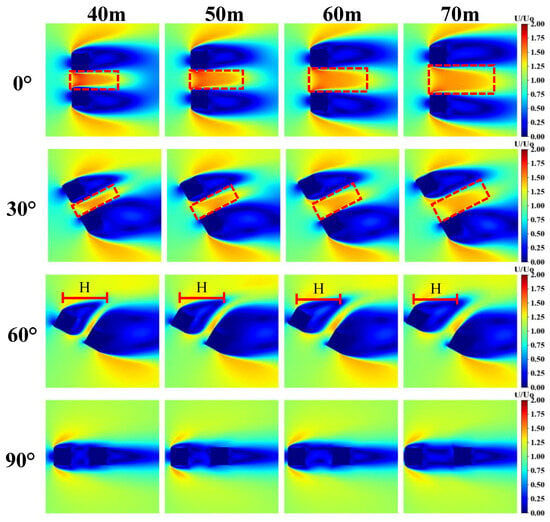
Figure 8.
Contours of dimensionless velocity magnitude (U/U0) at H = 40 m, 50 m, 60 m, and 70 m, and θ = 0°, 30°, 60°, 90°.
It can be observed in Figure 9 that as the wind speed increases, the flow characteristics in the same building layout also vary. At a wind direction angle of 0°, compared to the flow field at lower wind speeds, a small region of increased velocity appears in the low-speed region behind the building in high-speed flow. Similarly, at a wind direction angle of 45°, both low-speed regions behind the two buildings exhibit small regions of increased flow velocity. At a wind direction angle of 60°, with the increase in flow velocity, it is found that, in addition to the generation of high-speed regions within the low-speed region behind the building, two additional high-speed regions are observed above the rear of the buildings. These phenomena may be attributed to the instability of the flow field caused by the increase in wind speed. At a wind direction angle of 90°, apart from the increased length of the acceleration region at the windward corner of the building, as the incoming flow velocity increases, it can be observed that the width of the low-velocity region behind the downstream structures also increases, leading to an increase in the overall area, which is the cause of increased flow separation at the windward corners of the buildings.
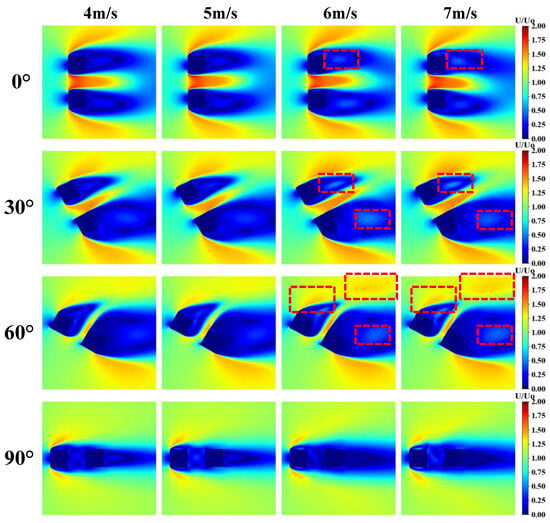
Figure 9.
Contours of dimensionless velocity magnitude (U/U0) at V = 4 m/s, 5 m/s, 6 m/s, and 7 m/s, and θ = 0°, 30°, 60°, 90°.
3.4. Optimization of Wind Environment
This section discusses the overall assessment of the building wind field. Because the mean velocity of the flow field as an evaluation metric is not able to reflect the flow characteristics, we introduced the wind speed acceptable coefficient as a measure of the quality of the building wind field. The coefficient is calculated by
where refers to the area with the range 0.3 < K < 1.2 of the acceptable wind speed region, and S represents the total area of the flow field. In this study, where the dimensionless velocity range is defined as the acceptable wind speed range, a larger value indicates a higher proportion of uniform wind speed areas in the flow field.
Figure 10 compares the results obtained from CFD simulations and the predictions of the CNN model. It can be observed that the predictions from the CNN model exhibit good consistency with the CFD results, indicating accurate prediction of the details of the building wind field by the model. Figure 10 also demonstrates that different wind speeds lead to varying levels of uniformity in the building wind field. Within the range of 4 m/s to 7 m/s, the uniformity of the building wind field decreases with increasing wind speed. Among the 196 cases studied, the case with the highest uniformity of the building wind field is observed at a wind speed of 4 m/s, a wind direction angle of 90°, and a building spacing of 45 m. On the other hand, the case with the lowest uniformity of the building wind field is found at a wind speed of 7 m/s, a wind direction angle of 90°, and a building spacing of 70 m. Under the same incoming wind speed, the uniformity of the building wind field also varies due to changes in the building layout and wind incidence angle. Specifically, at a wind speed of 4 m/s, the variation in the building layout results in the largest difference in the uniformity of the building wind field, , decreases from the highest value of 0.84 to the lowest value of 0.44, representing a 40% reduction in the area of the acceptable wind speed region, which corresponds to a 48% decrease. At a wind speed of 5 m/s, the building wind field uniformity is significantly affected by the building layout, with decreasing from 0.45 to 0.16. This corresponds to a 29% reduction in the area of the acceptable wind speed region, representing a 64% decrease.

Figure 10.
Comparison between CFD simulation and model predictions results of Auni.
Table 2 presents the optimized building layouts under four different incoming wind speeds. The optimal wind direction angle is 90° at a wind speed of 4 m/s and 0° at the other three wind speeds. The optimal building spacing for the four wind speeds is 45 m, 50 m, 70 m, and 55 m, respectively.

Table 2.
Results of optimization of building layouts with different inflow wind velocities.
Figure 11 illustrates the dimensionless wind velocity fields of the optimal building layouts at 4 inflow velocities. It can be observed that at a wind speed of 4 m/s, the optimal building layout is in a series arrangement. There is a small area of wind velocity amplification at the windward corner of the front building, and a low-velocity region forms behind the buildings. The downstream buildings are heavily influenced by the wake of the upstream buildings and are almost completely covered by it, resulting in a low-velocity region in the rear. Under the other wind speeds, a parallel arrangement is the optimal layout, where distinct wind velocity amplification and low-velocity regions form at the windward corners and behind the buildings, respectively.

Figure 11.
Contours of dimensionless velocity magnitude (U/U0) of the optimal building layouts with inlet velocity = 4 m/s (A), 5 m/s (B), 6 m/s (C), 7 m/s (D).
Figure 12 depicts the dimensionless wind velocity fields of the worst building layouts under the four wind speeds. It can be observed in each wind field that there is a noticeable wind velocity acceleration region at the windward corner of the buildings, and a large area of low-velocity region forms behind the buildings, thus reducing the area of acceptable wind velocity in the wind field. Therefore, optimizing the wind environment based on the building layout is crucial.

Figure 12.
Contours of dimensionless velocity magnitude(U/U0) of the worst building layouts with inlet velocity = 4 m/s (A), 5 m/s (B), 6 m/s (C), 7 m/s (D).
3.5. Prediction Efficiency Analysis
Traditional methods for optimizing building wind environments often rely on atmospheric boundary layer wind tunnel experiments or CFD simulation. However, these methods typically require high costs in terms of both experimental and computational resources. Given that deep learning models can benefit from GPU acceleration, this study proposes a deep learning-based surrogate model for optimizing the building wind environment. As shown in Figure 13, a comparison is made of the time required for predicting building wind fields using two methods employed in this study: the CFD model and the CNN model on a computer equipped with an Intel i5-13600KF CPU, Intel, Santa Clara, CA, USA (3.5 GHz, 20 cores, 32 GB RAM) and NVIDIA GeForce RTX 4080 GPU, Nvidia, Santa Clara, CA, USA (16 GB VRAM). For the optimization task presented in this study (196 cases), the CFD method requires approximately 15,680 s and the CNN method requires about 10,000 s, including the dataset generation (9600 s) and training time of the model (400 s) and the time for predicting the wind fields (10 s). This represents a reduction in time compared to using the CFD method alone. It is worth noting that the CFD method takes approximately 80 s to compute a single case, while the CNN model predicts a building flow field in just 9 milliseconds; the prediction time for a single building flow field using the CNN model is only 1/900th of the time required by the CFD method. Therefore, as the amount of data required for the optimization task increases, the time saved using the CNN model becomes even more significant.
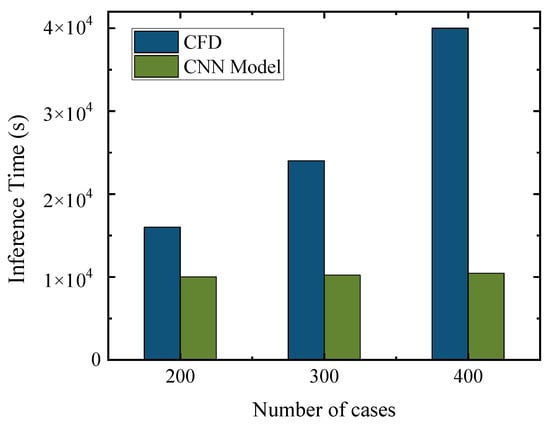
Figure 13.
Comparison of computational efficiency of CFD and CNN models.
4. Conclusions
In response to the high costs associated with CFD methods for studying building wind environments, this study focuses on the rapid optimization of building wind environments, achieving fast prediction and optimization of building wind environments using the CFD and CNN models. This study proposes a fast prediction and optimization method for building wind environments based on the U-Net deep learning surrogate model. The method is used to optimize the building wind environment for different building layouts, incoming wind speeds, and wind direction angles. The approach accurately learns the characteristics of the building wind field under various building layouts and incoming flow conditions, providing high prediction accuracy and low computational costs. The results demonstrate that the deep learning surrogate model accurately learns the building wind environment characteristics under different building layouts and incoming flow conditions compared to the results of CFD simulations. Compared to traditional CFD methods, the prediction of building wind environments using the CNN model can be accelerated by approximately 900, greatly improving the efficiency of predicting building wind environments and thus holding significant importance for building wind environment optimization; the optimized results are consistent with those obtained from CFD simulations, accurately predicting the building wind field for various building layouts and incoming flow conditions. This study also evaluates the building wind field using performance indicators. The optimal building layout and incoming flow conditions for the building wind environment in this study are a wind direction angle of = 90°, incoming wind speed = 4 m/s, and a building spacing of 45 m, with a uniformity coefficient Auni of 0.84, The worst building layout for the wind environment is a wind direction angle of = 90°, incoming wind speed = 7 m/s, and a building spacing of 45 m, with a uniformity coefficient Auni is 0.13.
The essence of deep learning lies in being data-driven, where the generalization and accuracy of the model depend on high-quality datasets. With the advancement of computer technology, more diverse and abundant building wind environment datasets can be constructed through CFD numerical simulations, laying a solid foundation for intelligent computation in the field of building wind environment engineering. Future works may include the study of wind environment characteristics for groups of buildings, enabling fast prediction and optimization of wind environments for different scales of building clusters, thus providing a cost-effective and powerful tool for urban building design and planning.
Author Contributions
Y.Y.: Conceptualization, Methodology, Software, Investigation, Data curation, Writing—Original draft. F.Y.: Writing-Reviewing and Editing. N.M.: Methodology, Writing—Reviewing and Editing, Supervision. All authors have read and agreed to the published version of the manuscript.
Funding
The study was supported by National Natural Science Foundation of China (NSFC Grant No. 52276092), and Shandong Provincial Natural Science Foundation, China (No.: ZR2020ME170).
Institutional Review Board Statement
Not applicable.
Informed Consent Statement
Not applicable.
Data Availability Statement
The raw data supporting the conclusions of this article will be made available by the authors on request.
Conflicts of Interest
The authors declare no conflicts of interest. The funders had no role in the design of the study, in the collection, analyses, or interpretation of data, in the writing of the manuscript, or in the decision to publish the results.
References
- Ramponi, R.; Blocken, B.; De Coo, L.B.; Janssen, W.D. CFD simulation of outdoor ventilation of generic urban configurations with different urban densities and equal and unequal street widths. Build. Environ. 2015, 92, 152–166. [Google Scholar] [CrossRef]
- Gousseau, P.; Blocken, B.; Stathopoulos, T.; van Heijst, G.J.F. CFD simulation of near-field pollutant dispersion on a high-resolution grid: A case study by LES and RANS for a building group in downtown Montreal. Atmos. Environ. 2011, 45, 428–438. [Google Scholar] [CrossRef]
- Du, Y.; Mak, C.M.; Li, Y. A multi-stage optimization of pedestrian level wind environment and thermal comfort with lift-up design in ideal urban canyons. Sustain. Cities Soc. 2019, 46, 101424. [Google Scholar] [CrossRef]
- Ramponi, R.; Blocken, B. CFD simulation of cross-ventilation for a generic isolated building: Impact of computational parameters. Build. Environ. 2012, 53, 34–48. [Google Scholar] [CrossRef]
- Kato, S.; Murakami, S.; Mochida, A.; Akabayashi, S.; Tominaga, Y. Velocity-pressure field of cross ventilation with open windows analyzed by wind tunnel and numerical simulation. J. Wind Eng. Ind. Aerodyn. 1992, 44, 2575–2586. [Google Scholar] [CrossRef]
- Chenari, B.; Dias Carrilho, J.; Gameiro Da Silva, M. Towards sustainable, energy-efficient and healthy ventilation strategies in buildings: A review. Renew. Sustain. Energy Rev. 2016, 59, 1426–1447. [Google Scholar] [CrossRef]
- Okaze, T.; Kikumoto, H.; Ono, H.; Imano, M.; Ikegaya, N.; Hasama, T.; Nakao, K.; Kishida, T.; Tabata, Y.; Nakajima, K.; et al. Large-eddy simulation of flow around an isolated building: A step-by-step analysis of influencing factors on turbulent statistics. Build. Environ. 2021, 202, 108021. [Google Scholar] [CrossRef]
- Stathopoulos, T. Wind environmental conditions around tall buildings with chamfered corners. J. Wind Eng. Ind. Aerodyn. 1985, 21, 71–87. [Google Scholar] [CrossRef]
- Kamei, I.; Maruta, E. Study on wind environmental problems caused around buildings in Japan. J. Wind Eng. Ind. Aerodyn. 1979, 4, 307–331. [Google Scholar] [CrossRef]
- Uematsu, Y.; Yamada, M.; Higashiyama, H.; Orimo, T. Effects of the corner shape of high-rise buildings on the pedestrian-level wind environment with consideration for mean and fluctuating wind speeds. J. Wind Eng. Ind. Aerodyn. 1992, 44, 2289–2300. [Google Scholar] [CrossRef]
- Stathopoulos, T.; Wu, H.; Bédard, C. Wind environment around buildings: A knowledge-based approach. J. Wind Eng. Ind. Aerodyn. 1992, 44, 2377–2388. [Google Scholar] [CrossRef]
- To, A.P.; Lam, K.M. Evaluation of pedestrian-level wind environment around a row of tall buildings using a quartile-level wind speed descripter. J. Wind Eng. Ind. Aerodyn. 1995, 54–55, 527–541. [Google Scholar] [CrossRef]
- Lam, K.M. Wind Environment Around the Base of a Tall Building With a Permeable Intermediate Floor. J. Wind Eng. Ind. Aerodyn. 1992, 44, 2313–2314. [Google Scholar] [CrossRef]
- Stathopoulos, T.; Storms, R. Wind environmental conditions in passages between buildings. J. Wind Eng. Ind. Aerodyn. 1986, 24, 19–31. [Google Scholar] [CrossRef]
- Tominaga, Y.; Shirzadi, M. Wind tunnel measurement of three-dimensional turbulent flow structures around a building group: Impact of high-rise buildings on pedestrian wind environment. Build. Environ. 2021, 206, 108389. [Google Scholar] [CrossRef]
- Kubota, T.; Miura, M.; Tominaga, Y.; Mochida, A. Wind tunnel tests on the relationship between building density and pedestrian-level wind velocity: Development of guidelines for realizing acceptable wind environment in residential neighborhoods. Build. Environ. 2008, 43, 1699–1708. [Google Scholar] [CrossRef]
- Ricci, A.; Burlando, M.; Freda, A.; Repetto, M.P. Wind tunnel measurements of the urban boundary layer development over a historical district in Italy. Build. Environ. 2017, 111, 192–206. [Google Scholar] [CrossRef]
- Tse, K.T.; Weerasuriya, A.U.; Zhang, X.; Li, S.W.; Kwok, K.C.S. Effects of twisted wind flows on wind conditions in passages between buildings. J. Wind Eng. Ind. Aerodyn. 2017, 167, 87–100. [Google Scholar] [CrossRef]
- Lin, Y.; Ichinose, T.; Yamao, Y.; Mouri, H. Wind velocity and temperature fields under different surface heating conditions in a street canyon in wind tunnel experiments. Build. Environ. 2020, 168, 106500. [Google Scholar] [CrossRef]
- Stathopoulos, T. Pedestrian level winds and outdoor human comfort. J. Wind Eng. Ind. Aerodyn. 2006, 94, 769–780. [Google Scholar] [CrossRef]
- Mochida, A.; Lun, I.Y.F. Prediction of wind environment and thermal comfort at pedestrian level in urban area. J. Wind Eng. Ind. Aerodyn. 2008, 96, 1498–1527. [Google Scholar] [CrossRef]
- Blocken, B.; Stathopoulos, T.; van Beeck, J.P.A.J. Pedestrian-level wind conditions around buildings: Review of wind-tunnel and CFD techniques and their accuracy for wind comfort assessment. Build. Environ. 2016, 100, 50–81. [Google Scholar] [CrossRef]
- Blocken, B.; Stathopoulos, T. CFD simulation of pedestrian-level wind conditions around buildings: Past achievements and prospects. J. Wind Eng. Ind. Aerodyn. 2013, 121, 138–145. [Google Scholar] [CrossRef]
- Blocken, B. LES over RANS in building simulation for outdoor and indoor applications: A foregone conclusion? Build. Simul. 2018, 11, 821–870. [Google Scholar] [CrossRef]
- Blocken, B. 50 years of Computational Wind Engineering: Past, present and future. J. Wind Eng. Ind. Aerodyn. 2014, 129, 69–102. [Google Scholar] [CrossRef]
- Stathopoulos, T. Computational wind engineering: Past achievements and future challenges. J. Wind Eng. Ind. Aerodyn. 1997, 67–68, 509–532. [Google Scholar] [CrossRef]
- Toparlar, Y.; Blocken, B.; Maiheu, B.; van Heijst, G.J.F. A review on the CFD analysis of urban microclimate. Renew. Sustain. Energy Rev. 2017, 80, 1613–1640. [Google Scholar] [CrossRef]
- Hang, J.; Li, Y.; Sandberg, M. Experimental and numerical studies of flows through and within high-rise building arrays and their link to ventilation strategy. J. Wind Eng. Ind. Aerodyn. 2011, 99, 1036–1055. [Google Scholar] [CrossRef]
- Zhang, S.; Kwok, K.C.S.; Liu, H.; Jiang, Y.; Dong, K.; Wang, B. A CFD study of wind assessment in urban topology with complex wind flow. Sustain. Cities Soc. 2021, 71, 103006. [Google Scholar] [CrossRef]
- García-Sánchez, C.; van Beeck, J.; Gorlé, C. Predictive large eddy simulations for urban flows: Challenges and opportunities. Build. Environ. 2018, 139, 146–156. [Google Scholar] [CrossRef]
- van Hooff, T.; Blocken, B.; Tominaga, Y. On the accuracy of CFD simulations of cross-ventilation flows for a generic isolated building: Comparison of RANS, LES and experiments. Build. Environ. 2017, 114, 148–165. [Google Scholar] [CrossRef]
- Guo, X.; Li, W.; Iorio, F. Convolutional Neural Networks for Steady Flow Approximation. In Proceedings of the 22nd ACM SIGKDD International Conference on Knowledge Discovery and Data Mining, San Francisco, CA, USA, 13–17 August 2016; ACM: New York, NY, USA, 2016; pp. 481–490. [Google Scholar]
- Ozaki, H.; Aoyagi, T. Prediction of steady flows passing fixed cylinders using deep learning. Sci. Rep. 2022, 12, 447. [Google Scholar] [CrossRef]
- Miyanawala, T.P.; Jaiman, R.K. An Efficient Deep Learning Technique for the Navier-Stokes Equations: Application to Unsteady Wake Flow Dynamics. arXiv 2018, arXiv:1710.09099. [Google Scholar] [CrossRef]
- Ribeiro, M.D.; Rehman, A.; Ahmed, S.; Dengel, A. DeepCFD: Efficient Steady-State Laminar Flow Approximation with Deep Convolutional Neural Networks. arXiv 2021, arXiv:2004.08826. [Google Scholar] [CrossRef]
- Duru, C.; Alemdar, H.; Baran, O.U. A deep learning approach for the transonic flow field predictions around airfoils. Comput. Fluids 2022, 236, 105312. [Google Scholar] [CrossRef]
- Duru, C.; Alemdar, H.; Baran, Ö.U. CNNFOIL: Convolutional Encoder Decoder Modeling for Pressure Fields Around Airfoils. Neural Comput. Appl. 2021, 33, 6835–6849. [Google Scholar] [CrossRef]
- Fang, R.; Sondak, D.; Protopapas, P.; Succi, S. Deep learning for turbulent channel flow. arXiv 2018, arXiv:1812.02241. [Google Scholar] [CrossRef]
- Thuerey, N.; Weißenow, K.; Prantl, L.; Hu, X. Deep Learning Methods for Reynolds-Averaged Navier–Stokes Simulations of Airfoil Flows. AIAA J. 2020, 58, 25–36. [Google Scholar] [CrossRef]
- Hartmann, D.; Meinke, M.; Schröder, W. Differential equation based constrained reinitialization for level set methods. J. Comput. Phys. 2008, 227, 6821–6845. [Google Scholar] [CrossRef]
- Yu, Y.; Chen, S.; Wei, H. Modified UNet with attention gate and dense skip connection for flow field information prediction with porous media. Flow Meas. Instrum. 2023, 89, 102300. [Google Scholar] [CrossRef]
- Mokhtar, S.; Sojka, A.; Davila, C.C. Conditional generative adversarial networks for pedestrian wind flow approximation. In Proceedings of the 11th Annual Symposium on Simulation for Architecture and Urban Design; Society for Computer Simulation International, San Diego, CA, USA, 25–27 May 2020; pp. 1–8. [Google Scholar]
- Wang, L.; Fournier, Y.; Wald, J.-F.; Mesri, Y. Identification of vortex in unstructured mesh with graph neural networks. Comput. Fluids 2024, 268, 106104. [Google Scholar] [CrossRef]
- Lino, M.; Fotiadis, S.; Bharath, A.A.; Cantwell, C. Towards Fast Simulation of Environmental Fluid Mechanics with Multi-Scale Graph Neural Networks. arXiv 2022, arXiv:2205.02637. [Google Scholar]
- Shao, X.; Liu, Z.; Zhang, S.; Zhao, Z.; Hu, C. PIGNN-CFD: A physics-informed graph neural network for rapid predicting urban wind field defined on unstructured mesh. Build. Environ. 2023, 232, 110056. [Google Scholar] [CrossRef]
- Liu, Z.; Zhang, S.; Shao, X.; Wu, Z. Accurate and efficient urban wind prediction at city-scale with memory-scalable graph neural network. Sustain. Cities Soc. 2023, 99, 104935. [Google Scholar] [CrossRef]
- Weerasuriya, A.U.; Zhang, X.; Lu, B.; Tse, K.T.; Liu, C.H. A Gaussian Process-Based emulator for modeling pedestrian-level wind field. Build. Environ. 2021, 188, 107500. [Google Scholar] [CrossRef]
- Kim, B.; Lee, D.-E.; Preethaa, K.R.S.; Hu, G.; Natarajan, Y.; Kwok, K.C.S. Predicting wind flow around buildings using deep learning. J. Wind Eng. Ind. Aerodyn. 2021, 219, 104820. [Google Scholar] [CrossRef]
- He, Y.; Liu, X.-H.; Zhang, H.-L.; Zheng, W.; Zhao, F.-Y.; Aurel Schnabel, M.; Mei, Y. Hybrid framework for rapid evaluation of wind environment around buildings through parametric design, CFD simulation, image processing and machine learning. Sustain. Cities Soc. 2021, 73, 103092. [Google Scholar] [CrossRef]
- Zahid Iqbal, Q.M.; Chan, A.L.S. Pedestrian level wind environment assessment around group of high-rise cross-shaped buildings: Effect of building shape, separation and orientation. Build. Environ. 2016, 101, 45–63. [Google Scholar] [CrossRef] [PubMed]
- Lim, J.; Ooka, R.; Lim, H. Multicollinearity issue for the parameterization of urban ventilation potential with urban morphology. Sustain. Cities Soc. 2022, 87, 104218. [Google Scholar] [CrossRef]
- Meng, Y.; Hibi, K. Turbulent measurements of the flow field around a high-rise building. Wind. Eng. 1998, 76, 55–64. [Google Scholar] [CrossRef]
- Yoshie, R.; Mochida, A.; Tominaga, Y.; Kataoka, H.; Harimoto, K.; Nozu, T.; Shirasawa, T. Cooperative project for CFD prediction of pedestrian wind environment in the Architectural Institute of Japan. J. Wind Eng. Ind. Aerodyn. 2007, 95, 1551–1578. [Google Scholar] [CrossRef]
- Ronneberger, O.; Fischer, P.; Brox, T. U-Net: Convolutional Networks for Biomedical Image Segmentation. In Medical Image Computing and Computer-Assisted Intervention—MICCAI 2015; Navab, N., Hornegger, J., Wells, W.M., Frangi, A.F., Eds.; Lecture Notes in Computer Science; Springer International Publishing: Cham, Switzerland, 2015; Volume 9351, pp. 234–241. ISBN 978-3-319-24573-7. [Google Scholar]
- Kingma, D.P.; Ba, J. Adam: A Method for Stochastic Optimization. arXiv 2017, arXiv:1412.6980. [Google Scholar]
Disclaimer/Publisher’s Note: The statements, opinions and data contained in all publications are solely those of the individual author(s) and contributor(s) and not of MDPI and/or the editor(s). MDPI and/or the editor(s) disclaim responsibility for any injury to people or property resulting from any ideas, methods, instructions or products referred to in the content. |
© 2024 by the authors. Licensee MDPI, Basel, Switzerland. This article is an open access article distributed under the terms and conditions of the Creative Commons Attribution (CC BY) license (https://creativecommons.org/licenses/by/4.0/).